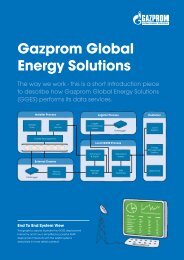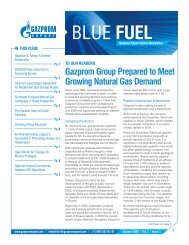October
October
October
Create successful ePaper yourself
Turn your PDF publications into a flip-book with our unique Google optimized e-Paper software.
<strong>October</strong> 2012 | Vol. 5 | Issue 3BLUE FUELin imported natural gas. However, there is little emphasisthat it is the final consumer who must cover the costs ofthese investments.The new energy policy often uses the term “energyindependency”or more precisely “seeking ways out of theenergy dependency.” The diversification of natural gas importsupply sources and the development of cross-border transportroutes can help achieve this “independency.”We believe that over the next few years, global energy willbe characterized by large uncertainties, especially in prices.So it is important to develop an energy policy that can adaptto these changing conditions.The aforementioned plans and goals, taking into accountIEA's medium-term gas market forecasts 4 , are a raceagainst time. Over the next 2-3 years, abundant supplyand stagnating demand will characterize the European gasmarkets. Market (hub) prices will not increase, while theprice of oil, which moves long-term gas contract prices, willstagnate at best.The existing gap between the market and contract prices islikely to remain constant in the medium term. By the end ofthe decade, European gas demand is expected to graduallyincrease; however, the evolution of gas prices is also influencedby the development of unconventional gas and LNG.Gazprom has recently amended its contract prices forcertain countries, translating into lower prices for many. Weexpect the Russian-Hungarian long-term gas contract to berenewed in 2015. Hopefully, the above mentioned factorswill play a role in the development of the new prices.Sources:1Source: Eurostat2Source: www.parlament.hu3Source: http://www.parlament.hu/irom39/03839/03839.pdf4Source: Medium-Term Gas MarketReport 2012 IEA 2012Developing a Partnership Between Wind and GasBy Nora Méray, Senior researcher, Clingendael International Energy ProgrammeIn December 2011, the Clingendael International EnergyProgram published a study on the relationship betweenwind power and natural gas in the power generation mix.Since then, this topic has become even more relevantas the profitability of most gas-fired power plants inNorthwest Europe came under pressure due to severalfactors, including higher natural gas prices, cheap coal, lowpenalties for CO 2emissions and falling electricity prices.The EU aims to have CO 2emissions be at least 20% lowerthan they were in 1990 by 2020 and at least 80% lower by2050, which would require CO 2emissions from powergeneration to approach near zero by 2050.Several studies have been published on ways to achievea low-carbon European power generation mix. The role offossil power generation suggested in these studies variesconsiderably, with some even proposing entirely renewableenergy-based mixes. At the same time, the technical andeconomic difficulties of developing and operating a largelyrenewables-based power system are also being recognized.While all studies agree that wind energy will be an essentialpart of a low carbon power generation mix, the variabilityand limited capacity credit of wind power present challengesto power generation.Wind power requires a large amount of back-up powergeneration capacity. Part of this back-up capacity is meantto deal with the short term variability and forecast error ofwind energy. A different type of back-up capacity is neededto address long periods (several hours to days) of low windpower supply.Continues on page 28www.gazpromexport.com | newsletter@gazpromexport.com | +7 (499) 503-61-61 | comm@gazpromexport.com 27ÝÊÑÏÎÐÒ
















